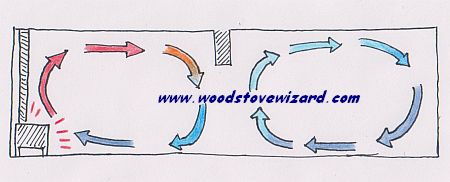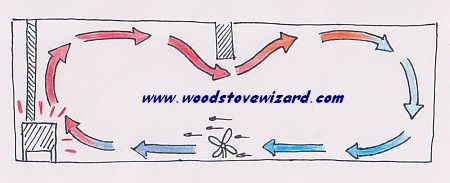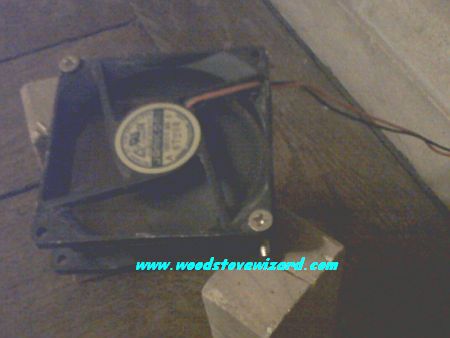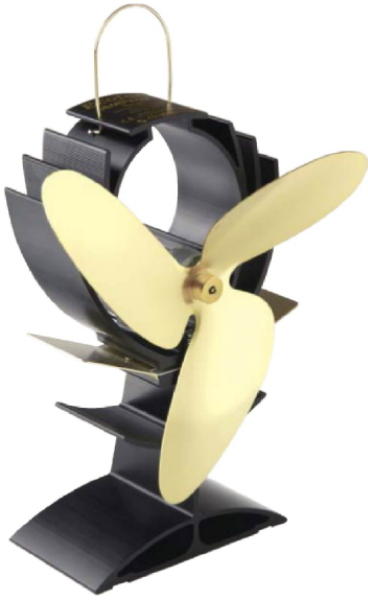Why Use a Wood Stove Fan?
Wood stove fans cover two main categories - those for boosting draft to the firebox and those designed to increase air circulation around your fire, and hence heat flow into the room.. I'm not planning on talking about those that feed combustion air to fireboxes directly here, although I may cover them in a future article.
Under normal circumstances the air circulation in your home may look something like this

Wood stove fans boost stove heating efficiency by improving the amount of heat that your stove can transfer to the air in your room, and also how that heat circulates around your house. Some houses have in built ducting to carry air from one section of the house to another - I don't have experience of these systems as they are not at all common in the UK, although I am led to believe that they are common in the US.
If you are lucky enough to have one of these systems then it can probably be controlled to circulate the air around your home moving heat from the hottest part of the house, where your wood stove is, to the coolest.
This forced circulation helps by spreading the energy from the stove to the farthest flung corners of your home - this stops the space with the stove overheating and reduces the need for additional heating in other parts of the house.

If you don't have a system built into your home it is unlikely that you will be thinking of building one - in that case you may find that giving the natural circulation of warm air within your home a helping hand will bring handsome benefits.
First, a few counter-intuitive things about air circulation:
- you don't need a massive wood stove fan to have a large impact - remember you are trying to boost the circulation that is already there
- if you want to move warm air from one room to another, the easiest approach is often to move cold air into the warmer room. The cold air flows in near the floor and circulation forces warm air out near the top
- Wood stove fans don't need to be anywhere near your wood stove to have a benefit - you might put one in the door between two distant rooms improve air circulation to the more remote parts of the building.
I've spent considerable time experimenting around my own home, using a simple smoke test to see where convection currents are carrying warmth to. By placing small simple, homemade fan units between doors we have made a noticeable difference to air temperatures in rooms away from the fire in cold weather.
The wood stove fans we have made, and I have to credit my father here for the creation of this masterpiece, are made from a couple of pieces of scrap wood, an old mobile phone charger and cooling fan salvaged from a PC! Talk about a cheap heating solution!

These simple little devices are small, portable and plug into an ordinary power socket - simply placing them on the floor in strategic places has a noticable impact on how warm distant rooms get. When not in use they get put away in a drawer.
They won't be everyone's cup of tea as they look 'homemade' but they are a simpler solution than cutting holes in walls to install heat ducting!
Here area few ideas for places to try putting a fan - remember we are simply trying to encourage the natural convection not force air where it doesn't 'want' to go.
- In the space near, beside or behind your wood stove, preferably blowing colder air from your room towards the hot stove
- In the door way between your sitting room and the rest of the house, blowing cold air into the sitting room - warm air will circulate back out at the top of the door way
- Between door ways of more remote rooms - blowing cold air at floor level towards the warmer space
Ecofans and Stirling Engines
In recent years a variety of different fans have come on to the market which sit directly on top of your wood stove. These are designed to move large volumes of air within the immediate vicinity of the stove itself and hence boost heat transfer from the stove surface to the air. This is a different effect from moving warm air from one part of the home to another. Two types of fan are of particular interest as they draw their power directly from the temperature of the stove itself. They don't need plugging into the mains and run whenever your stove is running.
Stirling Engine Powered Fans
Stirling Engines are on "old" technology that is coming back into fashion in many fields. If a car can be considered to be an internal combustion engine (the heat source is inside the mechanism) then these can be considered to be an external combustion engine. A heat source, in this case the hot metal of the stove, cause air to expand inside the cylinder of the engine which drives a piston. The piston turns the fan. The hotter the stove surface gets the faster the fan will turn and the more effective the fan is.
The Eco-fan
|
The Eco-Fan is another new piece of technology that has recently hit the market. These come in various styles but rely on the same technology for the power supply. The fan sits on the hot surface where alternating metallic strips generate a voltage and some current. This is enough to power the fan unit, which is optimised for transferring a large volume of air. These are relatively expensive at present. |
 |
